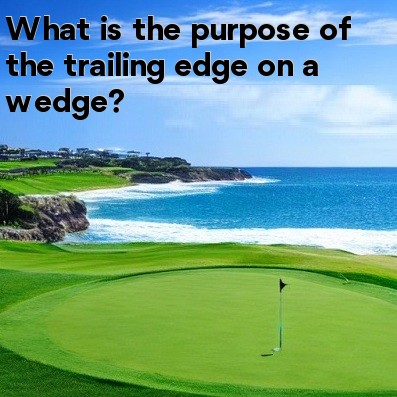
What is the Purpose of the Trailing Edge on a Wedge?
When it comes to golf clubs, wedges are an essential part of any golfer's bag. Wedges are designed to provide players with the necessary control and accuracy when hitting shots from close range, particularly around the greens. One key feature of a wedge is the trailing edge, which plays a crucial role in the club's performance. In this article, we will explore the purpose of the trailing edge on a wedge and its impact on a golfer's game.
- Enhanced Bounce: The trailing edge of a wedge is typically shaped in a way that enhances the club's bounce. Bounce refers to the angle between the leading edge and the trailing edge of the club's sole. A higher bounce angle on the trailing edge helps prevent the club from digging into the ground too much during impact, especially on softer turf or sand. This allows the club to glide through the surface smoothly, providing golfers with more consistent and predictable results.
- Improved Versatility: The trailing edge of a wedge also contributes to the club's versatility. By shaping the trailing edge in a certain way, club manufacturers can influence how the club interacts with various lies and conditions. For example, a wedge with a wider trailing edge can be effective for shots from soft bunkers or fluffy lies in the rough, as the wider sole prevents the club from sinking too deeply into the ground. On the other hand, a narrower trailing edge is more suitable for firm surfaces, allowing the golfer to take cleaner strikes with better precision.
- Optimal Turf Interaction: The trailing edge plays a crucial role in how the wedge interacts with the turf during impact. A properly designed trailing edge can help minimize the likelihood of the club getting stuck in the ground and allow for cleaner contact with the ball. Additionally, the trailing edge can prevent unwanted vibrations and dampen the impact feel, providing a more solid and satisfying sensation to the golfer upon striking the ball.
- Spin and Control: Another important aspect influenced by the trailing edge is the generation of spin and control. The shape, size, and design of the trailing edge can influence how the club interacts with the ball, which ultimately affects the spin rate. A well-designed trailing edge can help golfers produce more backspin, allowing them to stop the ball quickly on the greens and have better control over their approach shots.
- Visual Alignment: While the primary function of the trailing edge is related to performance, it can also have an impact on a golfer's alignment. Some wedges feature a leading edge that is higher than the trailing edge, providing a visual aid to square the clubface at address. This alignment feature can help golfers align their shots accurately, resulting in better ball-striking consistency and more predictable outcomes.
In conclusion, the trailing edge of a wedge serves multiple purposes that enhance a golfer's performance. From enhanced bounce and improved versatility to optimal turf interaction and spin generation, the trailing edge plays a crucial role in providing control and accuracy around the greens. By understanding the importance of the trailing edge, golfers can make more informed decisions when choosing their wedges, leading to improved performance on the course.





